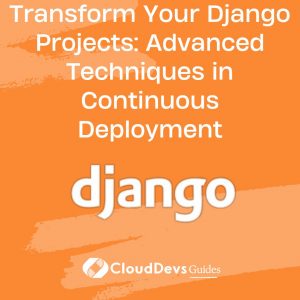Transform Your Django Projects: Advanced Techniques in Continuous Deployment?
In the realm of modern web development, Django stands out as a preferred framework for many Python developers. Its robust and efficient nature makes it ideal for rapid development without compromising on professional standards. Integrating Django with Continuous Deployment (CD) streamlines the process of deploying web applications, ensuring a faster, safer, and more efficient workflow. You can hire Django Developers for your projects to ensure greater success.
Table of Contents
1. Setting Up Your Django Project for Continuous Deployment
- Environment Variables: It’s crucial to manage settings like database URLs, API keys, and other sensitive information using environment variables. This approach keeps different values for development and production separate and secure..
- Handling Migrations: Managing Django migrations effectively is key. It involves committing migration files, resolving conflicts, and sometimes squashing migrations for efficiency. Each project’s migration approach may vary based on architecture and model complexity.
- Continuous Integration: Implementing Continuous Integration (CI) ensures that tests are run as soon as new code is pushed. This step is essential, especially in collaborative environments, to maintain code quality and functionality.
- Deployment Checklist: Django provides an official deployment checklist, which is a valuable resource for ensuring the security and performance of your project. This checklist covers critical settings like SECRET_KEY, DEBUG, ALLOWED_HOSTS, and database configurations, as well as performance optimizations and error reporting strategies.
2. Creating a Continuous Deployment Pipeline
- Prerequisites: Basic knowledge of Python and a GitHub account are essential. Additionally, having accounts with Heroku and CircleCI will facilitate the deployment process.
- Cloning and Running the Sample Django Project: Start by cloning a sample Django project, setting it up on your local system, and then running it using the Python server.
- Setting Up a Heroku App: Create a new app in your Heroku dashboard. This step is crucial for hosting your Django application.
- Configuring CircleCI for Deployment: Once your project is pushed to GitHub, you need to set it up in CircleCI. This involves adding environment variables for authenticated access to your Heroku application.
- Automating Django App Deployment on Heroku: Install Gunicorn and other required packages, update your `requirements.txt` file, and configure the `Procfile` for Heroku deployment. This setup ensures that your Django application is ready for deployment on Heroku.
- Writing the Continuous Deployment Pipeline Script: Create a `.circleci` folder with a `config.yml` file in your project root. This configuration automates the deployment process from your GitHub repository to Heroku.
Conclusion
The integration of Django with Continuous Deployment using tools like CircleCI and Heroku simplifies the deployment process. It ensures that your Django application remains up-to-date with the latest code changes and is deployed efficiently and securely. This approach not only saves time but also significantly reduces the potential for human error, making it an indispensable practice for modern web development.
For further details on setting up and managing your Django project for continuous deployment, refer to the comprehensive guides and tutorials provided by freeCodeCamp Django in the wild: tips for deployment survival, CircleCI’s (Create a continuous deployment pipeline for Django applications, and the Django documentation’s Deployment checklist. These resources offer invaluable insights and step-by-step instructions to streamline your deployment process.
You can check out our other blog posts to learn more about Django. We bring you a complete guide titled Django and Accessibility: Building Inclusive Web Applications along with the Django and Scalability: Building Web Apps for High Traffic and Django Templates: Creating Dynamic and Responsive Web Pages which will help you understand and gain more insight into the Django programming language.
Table of Contents







